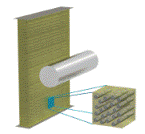Mechanical & Materials Engineering, Department of
Date of this Version
Winter 12-2013
Abstract
Diffuse ultrasonic backscatter measurements have been especially useful for extracting microstructural information and for improving flaw detection in materials. In this dissertation, this approach is applied to inspection of railroad wheels. To improve the wear resistance, the tread surfaces of railroad wheels are usually quenched with water to increase the hardness. The pearlite phase of iron, characterized by alternating ferrite and cementite phases, is created by the quenching and the lamellar spacing within grains increases progressively from the quenched tread surface to deeper locations due to the non-uniform cooling rate. The quench depth is an important parameter governing the wheel performance.
In this dissertation, several aspects of ultrasonic methods are studied. A new singly-scattered response (SSR) model that includes lamellar duplex microstructure within grains is developed to investigate the dependence of ultrasonic backscatter on such a microstructure in pearlitic wheel steel. An ultrasonic attenuation model is developed to study the influence of pearlite phase on ultrasonic attenuation. The experimental results show that both ultrasonic scattering amplitudes and longitudinal attenuation drop dramatically near the tread surface of a quenched wheel due to the presence of pearlite. The quench depth is measured by fitting the variance curve from the tread surface with the SSR model that includes the graded lamellar spacing on the propagation path. A mode-converted (longitudinal-to-transverse, or L-T) SSR model that includes duplex microstructure within grains is also developed to examine the preferred orientation of microstructure in a quenched sample. Finally, the dependence of ultrasonic backscatter on stress is verified by observing the decrease of backscatter amplitudes measured from a 1018 steel block under a uniaxial load. The experimental results show a trend that is similar to the theoretical prediction. The residual stress in a quenched steel sample is estimated by quantifying the change of backscatter amplitudes with and without residual stress.
Diffuse ultrasonic backscatter techniques exhibit strong sensitivity to duplex microstructure, texture and stress, outcomes that can be applicable for quality control including microstructure evaluation, measurement of quench depth and residual stress.
Adviser: Joseph A. Turner
Included in
Acoustics, Dynamics, and Controls Commons, Applied Mechanics Commons, Metallurgy Commons


Comments
A DISSERTATION Presented to the Faculty of The Graduate College at the University of Nebraska In Partial Fulfillment of Requirements For the Degree of Doctor of Philosophy, Major: Mechanical Engineering and Applied Mechanics, Under the Supervision of Professor Joseph A. Turner. Lincoln, Nebraska: December, 2013
Copyright (c) 2013 Hualong Du